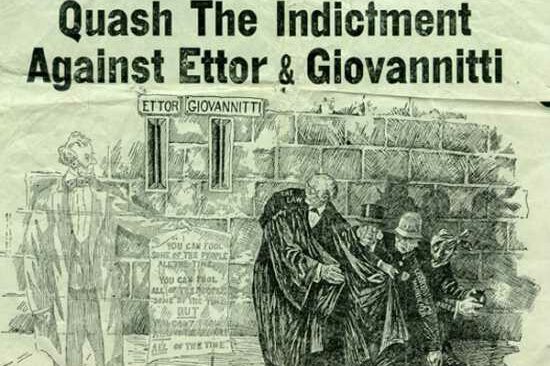Dear readers,
Deported is a word we associate with “ordered to leave the US” but it turns out deporting boats float both ways…
Italy did not exist as a nation in the early 1800s, and the Italian exiles who arrived in New York came directly from Austrian prisons. Most of them were political dissidents. In 1835, the new Austrian Emperor Ferdinand II offered an amnesty to Italian prisoners held in the dungeon at Spielberg, on the condition they got out and stayed out, that is, they accepted perpetual banishment. Most of these prisoners were youthful revolutionaries called carbonari, who had been in their early twenties at the time of their arrest. Felice Foresti, who later would become a professor of Italian literature at Columbia University and serve as representative for the Roman Republic in America, had been in Austrian dungeons for 18 years. Foresti was a young lawyer born in Ferrara.
In a book called My Prisons, author Silvio Pellico wrote an account of the suffering endured by Italian patriots at Spielberg and other Austrian dungeons. In August 1836, having accepted the offer of amnesty, about twenty such men were put aboard an imperial Austrian brig in the Adriatic and brought to New York under guard.
In New York, still technically prisoners, they were received by the Austrian Consul who liberated them to American authorities. The American press hailed these “martyrs of Spielberg” and, as the New York Times pointed out in a piece welcoming them to American, they were not immigrants but exiles; and “we sincerely trust these worthy victims of despotism may be able to find hospitable sympathy in our country until a change for the better in the politics of the European Cabinets may afford them an honorable occasion to return to their homeland.”
Arriving in 1836, most of them found it difficult to adapt to an environment that was wholly new. They had to learn a new language, embrace new customs, and there was no “Little Italy” area to make the transition easier. Most men lived quiet, rather melancholic lives as political exiles. Some earned a precarious living teaching Italian at home, however, two Sicilians, Pietro Bachi and Luigi Monti became Harvard professors. Later, Luigi Monti served as American Consul to Palermo (after 1861).
Louis Tinelli, a Lombard lawyer who had established a silk spinning plant near Lake Como prior to his arrest by Austrian police, established, with the help of some American friends, mulberry groves and a silk spinning plant in New Jersey, winning a gold medal from the institute of American Industry in 1840. He was appointed a United States Consul to Portugal in 1841 and, during the Civil War, he helped form an Italian regiment in New York, then saw action himself as a Colonel in the Union Army. His two sons were also Union soldiers. Before dying, in 1873, Tinelli asked to be buried in Brooklyn.
By 1850, eluding the Austrians, many political prisoners fled to New York. New York was a different kind of town when Giuseppe Garibaldi, himself fleeing the Austrians, sailed aboard the English packet ship Waterloo and reached America in 1850.
In a mid-century census taken that year, only 3,045 Italian residents were counted in the entire United States. Italian immigrants were already crossing the Atlantic Ocean by the thousands, but they were bound for the countries of South America, particularly Brazil and Argentina, where they could dwell with other Latin people and where the process of assimilation promised to be smoother and more rapid.
Since Italy did not exist as a nation, but as a geographical description, if a citizen of Venice emigrated to, say, Philadelphia, he did so as an Austrian subject, who could expect very little support from the Austrian consular officials in the United States. An immigrant from Naples would have been, on the other hand, a citizen of the Kingdom of Naples.
***
Quarantine as we know it began in Venice in the 14th century, in an effort to protect coastal cities from plague epidemics. The term used for the isolation was “quaranta giorni,” hence the name “quarantena” in Italian and “quarantine” in English. The Venetian forty-day quarantine proved to be an effective formula for handling outbreaks of the plague. Scientists now know that bubonic plague has a thirty-seven day period from incubation to death. That’s why the Venetian “quaranta giorni” were successful.
Cari lettori,
Deportato è una parola che associamo a “persona a cui è stato ordinato di lasciare gli Stati Uniti”, ma poi si scopre che le navi per le espulsioni galleggiano in entrambe le direzioni…
All’inizio del 1800, l’Italia come nazione non esisteva e gli esuli italiani che arrivarono a New York provenivano direttamente dalle carceri austriache. La maggior parte di loro erano dissidenti politici. Nel 1835 il nuovo imperatore austriaco Ferdinando II offrì l’amnistia ai prigionieri italiani detenuti nelle segrete di Spielberg, a condizione che uscissero e restassero fuori, cioè accettassero l’esilio perpetuo. La maggior parte di questi prigionieri erano giovani rivoluzionari chiamati carbonari, che avevano poco più di vent’anni al momento del loro arresto. Felice Foresti, che in seguito sarebbe diventato professore di letteratura italiana alla Columbia University e avrebbe servito come rappresentante della Repubblica Romana in America, era rimasto nelle segrete austriache per 18 anni. Foresti era un giovane avvocato nato a Ferrara.
In un libro intitolato My Prisons, l’autore Silvio Pellico ha scritto un resoconto delle sofferenze subite dai patrioti italiani a Spielberg e in altri sotterranei austriaci. Nell’agosto 1836, accettata l’offerta di amnistia, una ventina di uomini furono imbarcati su un brigantino imperiale austriaco nell’Adriatico e portati a New York sotto scorta.
A New York, ancora tecnicamente prigionieri, furono ricevuti dal console austriaco che li consegnò alle autorità americane. La stampa americana salutò questi “martiri di Spielberg” e, come sottolineò il New York Times in un pezzo che li accoglieva in America, non erano immigrati ma esuli: “Siamo sinceramente fiduciosi che queste degne vittime del dispotismo possano trovare un’ospitale accoglienza nel nostro Paese fino a quando un cambiamento in meglio nella politica dei gabinetti europei potrà offrire loro un’occasione onorevole per tornare in patria”.
Arrivati nel 1836, la maggior parte di loro ebbe difficoltà ad adattarsi a un ambiente del tutto nuovo. Dovettero imparare una nuova lingua, abbracciare nuove usanze e senza una “Little Italy” per facilitare la transizione. La maggior parte degli uomini visse una vita tranquilla, piuttosto malinconica da esuli politici. Alcuni si guadagnavano una vita precaria insegnando italiano in casa, tuttavia, due siciliani, Pietro Bachi e Luigi Monti divennero professori di Harvard. Successivamente, Luigi Monti servì come Console americano a Palermo (dopo il 1861).
Louis Tinelli, avvocato lombardo che prima di essere arrestato dalla polizia austriaca aveva impiantato una filanda di seta vicino al lago di Como, realizzò, con l’aiuto di alcuni amici americani, dei gelseti e una filanda per la seta nel New Jersey, vincendo una medaglia d’oro dall’Institute of American Industry nel 1840. Fu nominato Console degli Stati Uniti in Portogallo nel 1841 e, durante la guerra civile, aiutò a formare un reggimento italiano a New York, poi vide l’azione lui stesso come colonnello nell’esercito dell’Unione. Anche i suoi due figli furono soldati dell’Unione. Prima di morire, nel 1873, Tinelli chiese di essere sepolto a Brooklyn.
Nel 1850, sfuggendo agli austriaci, molti prigionieri politici fuggirono a New York. New York era una città diversa quando Giuseppe Garibaldi, egli stesso in fuga dagli austriaci, salpò a bordo del mercantile inglese Waterloo e raggiunse l’America nel 1850.
In un censimento su metà del secolo condotto quell’anno, risultavano solo 3.045 residenti italiani in tutti gli Stati Uniti. Gli immigrati italiani stavano già attraversando l’Oceano Atlantico a migliaia, ma erano diretti verso i Paesi del Sud America, in particolare il Brasile e l’Argentina, dove avrebbero potuto abitare con altri popoli latini e dove il processo di assimilazione si annunciava più agevole e rapido.
Poiché l’Italia non esisteva come nazione ma solo come descrizione geografica, se un cittadino di Venezia emigrava, diciamo, a Filadelfia, lo faceva come suddito austriaco, che poteva aspettarsi ben poco sostegno dai funzionari consolari austriaci negli Stati Uniti. Un immigrato napoletano sarebbe stato, invece, cittadino del Regno di Napoli.
***
La quarantena, così come la conosciamo, iniziò a Venezia nel XIV secolo, nel tentativo di proteggere le città costiere dalle epidemie di peste. Il termine utilizzato per l’isolamento era “quaranta giorni”, da cui il nome “quarantena” in italiano e “quarantine” in inglese. La quarantena veneziana di quaranta giorni si è rivelata una formula efficace per gestire i focolai di peste. Gli scienziati ora sanno che la peste bubbonica ha un periodo di trentasette giorni dall’incubazione alla morte. Ecco perché i “quaranta giorni” veneziani ebbero successo.






























